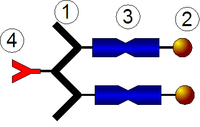
Photo from wikipedia
Abstract Organic/Inorganic hybrid systems present a promising alternative for the creation of high-performance materials due to their biphasic structure that imparts multifunctional properties. The sol-gel process which initiated with the… Click to show full abstract
Abstract Organic/Inorganic hybrid systems present a promising alternative for the creation of high-performance materials due to their biphasic structure that imparts multifunctional properties. The sol-gel process which initiated with the synthesis of inorganic glasses has now become a synthetic route for organic-inorganic assemblies due to several advantages such as mild processing conditions and the freedom to play with the structures of precursors. This versatility of the low-temperature sol-gel process provides an opportunity to engineer both the phases resulting in a synergistic combination or entirely new set of properties fruitful for different applications. This review highlights the several pathways for synthesis of silica particles, the interfacial modification and the classification of hybrid materials based on the method of incorporation of an inorganic moiety in the organic matrix along with the structure-property relationship, and the characterization to develop a fundamental understanding of the process. The nature of bonding between the two different species greatly affects the hybrid nanostructure and thus, the bulk properties of the system. In particular, acrylate/silica system has been focused due to its distinctive properties such as transparency, gloss, and strength that find large-scale application in the field of coatings, plastics and rubbers.Abbreviations: °: Degree; °C: Degree Celsius; 1H NMR: Proton nuclear magnetic resonance; A°: Angstrom; AHAS: N-(3-acryloxy-2-hydroxyl propyl)-3-amino-propyltriethoxysilane; AIBA: 2,2′-Azobis(2-methylpropionamidine) dihydrochloride; AIBN: 2,2′-Azobis(2-methylpropionitrile); Al: Aluminium; APDMES: Aminopropyldimethylethoxysilane; APTES: 3-Aminopropyltriethoxysilane; ATRP: Atom transfer radical polymerization; CERAMERS: Ceramically Modified Monomers; CTAB: Cetyltrimethylammonium bromide; DFMA: Dodecafluoroheptyl methacrylate; DMF: Dimethylformamide; DPSD: Diphenylsilanediol; FESEM: Field Emission Scanning Electron Microscope; FTIR: Fourier-transform infrared spectroscopy; GPTMS: 3-Glycidoxypropyltrimethoxysilane; HDTMS: Hexadecyltrimethoxysilane; HEMA: 2-Hydroxyethyl methacrylate; HLB: Hydrophilic-Lyophilic Balance; HMDS: Hexamethyldisilazane; HPC: Hydroxypropyl Cellulose; IPN: Interpenetrating Network; KPS: Potassium persulfate; LCST: Lower critical solution temperature; McPTMS: 3-Mercaptopropyltrimethoxysilane; MOI: 2-(methacryloyloxy)ethyl isocyanate; MPEGMA: Monomethoxy-capped poly(ethylene glycol) methacrylate; MPTMS: 3-methacryloxypropyltrimethoxysilane; MTC: 2-(methacryloyl) ethyltrimethylammonium chloride; MTES: Methyltriethoxysilane; MTMS: Methyltrimethoxysilane; NMP: Nitroxide-Mediated Polymerization; ORMOCERs: Organically Modified Ceramics; ORMOSILs: Organically Modified Silica; OTES: Octyltriethoxysilane; OTMS: Octadecyltrimethoxysilane; PAA: Poly(acrylic acid); PDMS: Polydimethylsiloxane; PEO-PPO-PEO: Poly (ethylene oxides)-b-poly (propylene oxides)-b-poly (ethylene oxides); PHPS: Perhydropolysilazane; PMMA: Poly(methyl methacrylate); POSS: Polyhedral Oligomeric Silsesquioxane; PTMO: Poly(tetramethylene oxide); PTMS: Phenyltrimethoxysilane; PTMS: Phenyltrimethoxysilane; PVP: Poly (vinylpyrrolidone); RAFT: Reversible addition- fragmentation chain transfer; Si: Silicon; Sn: Tin; Ta: Tantalum; TBN: 4-(triethoxysilyl)butyronitrile; TEM: Transmission Electron Microscopy; TEMED: N,N,N′,N′-tetramethylethylenediamine; TEOS: Tetraethoxysilane; Tg: Glass-Transition Temperature; THF: Tetrahydrofuran; Ti: Titanium; TMOS: Tetramethoxysilane; UV: Ultraviolet; VTES: Vinyltriethoxysilane; VTMS: Vinyltrimethoxysilane; Zr: Zirconium Highlights Advantages of hybrid systems over the conventional materials Discusses the fundamental aspects of sol-gel chemistry Focusses on a detailed classification of hybrid polymers Covers different synthetic strategies, properties, and applications in diverse fields Graphical Abstract
Journal Title: Journal of Dispersion Science and Technology
Year Published: 2019
Link to full text (if available)
Share on Social Media: Sign Up to like & get
recommendations!